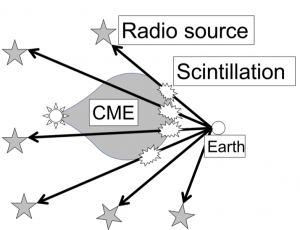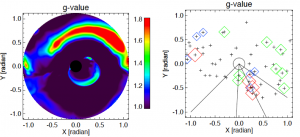Kazumasa Iwai (ISEE/Nagoya University)
Coronal mass ejections (CMEs) cause disturbances in the environment of the Earth when they arrive at the Earth. However, the prediction of the arrival of CMEs still remains a challenge. The propagating CMEs in the interplanetary space causes the scattering of radio waves; this phenomenon is called interplanetary scintillation (IPS). The IPS observation using the ground-based radio observations should be a useful tool to detect the CMEs (Figure 1).
We have developed an IPS estimation system based on a global magnetohydrodynamic (MHD) simulation of the inner heliosphere to predict the arrival time of CMEs. In this system, the initial speed of a CME is roughly derived from white-light coronagraph observations. Then, the propagation of the CME is calculated by a global MHD simulation. The IPS response is estimated by the three-dimensional density distribution of the inner heliosphere derived from the MHD simulation. The simulated IPS response is compared with the actual IPS observations made by the Institute for Space-Earth Environmental Research (ISEE), Nagoya University, and shows good agreement with that observed (Figure 2). We demonstrated how the simulation system works using a halo CME event generated by a X9.3 flare observed on September 5, 2017. We find that the CME simulation that best estimates the IPS observation can more accurately predict the time of arrival of the CME at the Earth. These results suggest that the accuracy of the CME arrival time can be improved if our current MHD simulations include IPS data.
Reference
Kazumasa Iwai, Daikou Shiota, Munetoshi Tokumaru, Ken’ichi Fujiki, Mitsue Den, Yûki Kubo, “Development of a coronal mass ejection arrival time forecasting system using interplanetary scintillation observations”
Earth, Planets and Space, 71,39, 2019, https://doi.org/10.1186/s40623-019-1019-5

Figure 1
Schematic image of the IPS observation that detect the propagating CME in the interplanetary space.
Figure 2
(Left) Estimated IPS data derived from the MHD simulation developed in this study. (Right) Observed IPS data using the radio telescope of ISEE, Nagoya university.

